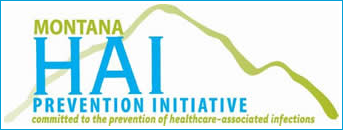Infection Control and Prevention/Healthcare Associated Infection Section
Infection control is an essential component of any health care delivery. Infection control measures can be as simple as hand washing and as sophisticated as high-level disinfection of surgical instruments. Implementing these measures can prevent transmission of disease in health care settings and the community.
Infection control is a key concept in achieving the Montana DPHHS's mission to protect and promote the health of Montanans through prevention, science and the assurance of quality health care delivery.
Healthcare-associated infections (HAIs) are infections that are acquired by patients within a healthcare setting while they are receiving care. These infections may occur in all types of healthcare facilities, including hospitals, outpatient surgery centers, nursing homes, or rehabilitation facilities. HAIs are largely preventable, yet are the most common complication of healthcare and can cause significant morbidity and mortality.

A healthcare-associated prevention initiative is a coordinated effort to reduce and prevent infections that patients can acquire during medical treatment. This initiative includes Infection Prevention and Control (IPC), antibiotic stewardship, surveillance and outbreak response, education and training, and data and research.
HAIs are listed among the top ten leading causes of death in the United States.
It was estimated in 2009 there were 1,737,125 HAIs in US hospitals with 26% attributed by catheter associated urinary tract infections and 17% attributed by surgical site infections.
Other major sources of infections included infection with Clostridium difficile, central line associated bloodstream infections, and ventilator associated pneumonia.
In 2016, infections caused by antibiotic resistant organisms in healthcare settings were also identified as being a significant problem. Methicillin-resistant Staphylococcus aureus (MRSA) infections and Carbapenem-resistant Enterobacteriaceae (CRE) have been identified as two organisms of interest.
These infections were deemed preventable and the National Action Plan to Prevent Health Care-Associated Infections: Road Map to Elimination was activated to reduce HAIs nationwide.
To track the reduction, more than 17,000 hospitals throughout the US currently identify and report the above mentioned HAIs to the National Healthcare Safety Database (NHSN).
The results have been analyzed to evaluate progress towards national goals.
In October, 2016, after reaching previous national goals, new targets for improvement were identified.
To encourage reduction of HAI, Medicare payments have been reduced to hospitals with high HAI rates.
Additionally, HAI rates have been incorporated into Hospital Compare rankings which are comprised of many quality measures and can assist consumers who want to select a hospital that provides quality care.
What does Montana’s HAI Program do?
This program has provided support to healthcare facilities since 2012 through the Epidemiology and Laboratory Capacity Cooperative agreement with CDC.
The funding supports these Montana activities:
- Improve accurate reporting of HAIs to the NHSN database
- Coordinate and implement HAI prevention activities
- Improve infection prevention breadth and scope at healthcare facilities
- Detect and help mitigate outbreaks that occur in healthcare facilities
- Educate providers to prescribe antibiotics appropriately
- Assist hospitals and other healthcare facilities to have strong Antibiotic Stewardship Programs
Montana hospitals have reduced HAIs as reported here.

